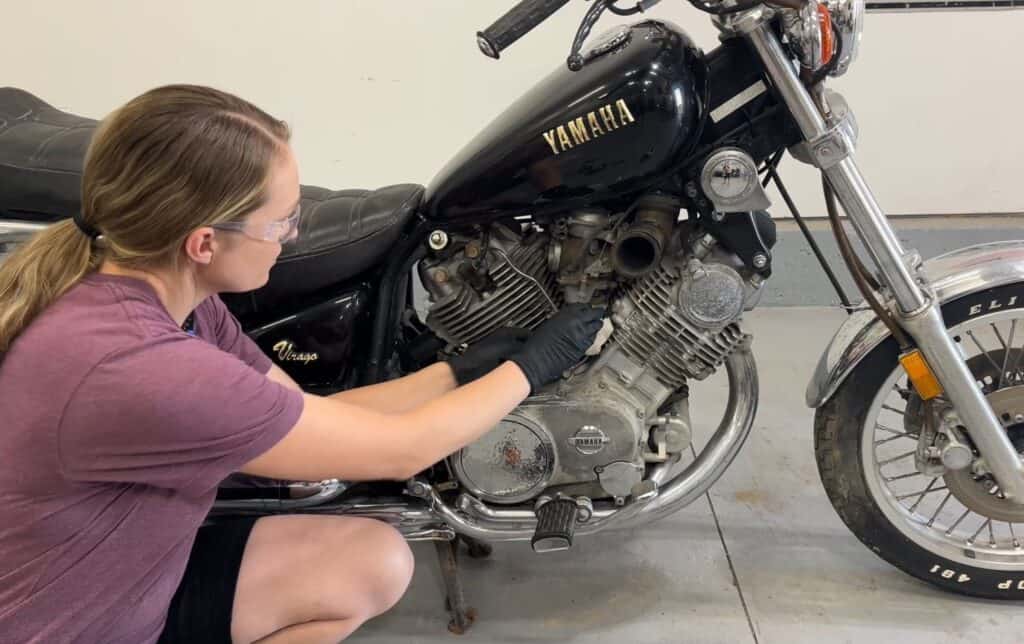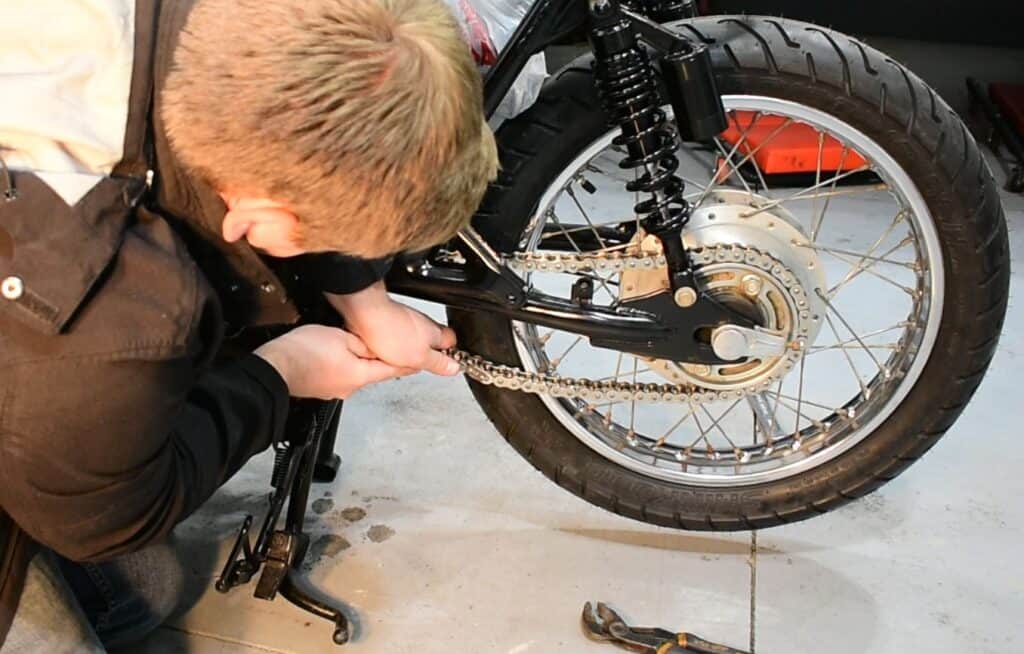
There are a lot of different reasons why you may want to improve your motorcycle. Perhaps it does not perform quite like you would like it to. Perhaps it is not running as smooth as you think it should. The remedy for many of these issues is a tune-up.
What does it mean to tune a motorcycle? Tuning a motorcycle means making small changes in order to optimize power and fuel economy. This is done by altering the air-fuel ratio on the carburetors, adjusting valve clearance, changing fluids, and performing other regular maintenance items.
If you have owned a motorcycle for a while, you will probably see it decline in performance and fuel economy over time. You may notice that your motorcycle may not be as fast as others who have the exact same model as you. You might start to experience hiccups as you try to accelerate and realize that it is not as smooth as it once was. Let me further explain how to fix that.
What A Tune Up Includes
The key to remedying these scenarios is a tune-up. By adjusting just a few simple things, you can significantly improve the performance of your motorcycle and get it back running like it did when you first bought it.
Tune-ups are a higher-level maintenance for your bike than you normally perform. This is more than just changing your oil and putting air in your tires. A tune-up covers many of the things that are rarely performed. Doing all these things can optimize the way that your bike runs.
So, you have heard about what a tune-up can do for your motorcycle, but what exactly constitutes a tune-up? There are many different things that could fall under the realm of a tune-up. What steps certain people consider part of a tune-up differs from person to person.
The very basis of a tune-up is making sure that every component in your bike is running as it should. This could include things like:
- Checking/changing out brake fluid
- Replacing air filters
- Replacing brake pads
- Lubricating and tightening your chain
- Adjusting the valves
- Tuning the carburetors
- Coolant flush
- Tire balance
Depending on your schedule, these things could all be done at different points in time, but they are all critical to your motorcycle’s overall performance.
One very critical aspect of motorcycle ownership is the maintenance of your chain (or belt if you have a belt-driven motorcycle). This does require regular tightening and lubrication in order to function properly. Your chain goes through heavy abuse and as a result will wear faster than the rest of your motorcycle.
Taking proper care of the chain will maximize its life and save you money. Rust can also start to form on the chain. When doing a tune-up, you can clean this rust off to help your chain to last as long as possible.
Another step of a tune-up would be to tune your carburetor. Doing this will maximize your performance in regard to power as well as fuel economy. This will alter your current air/fuel ratio which will greatly affect the way in which your bike runs. This can be the trickiest part of an engine tune-up. All of the beforementioned things are important to ensuring that your bike is operating at it is very best each day.
How To Do A Tune Up Yourself

Can you perform a tune-up yourself? The answer is that all of these things can be done with very little hands-on experience and limited tools. A big majority of these tune-up items can be learned by watching a quick YouTube video or reading a how-to guide.
To see some of the basic tools that I first started out with, check out my recommended tools page here. These few tools can do a majority of all the work you’ll ever have to do on your motorcycle.
Let us start with the easier things first. One of the simplest things that you can do is change the air filter on your motorcycle. This can require as little tools as just a single screwdriver. All you need to do is locate your air filter, take it off, and put the new one on. It is that simple.
Next come the brakes. Brake pads can be changed with limited tools as well. Once you have the new brake pads that you need, it is just a matter of taking off the wheels, removing the old brake pads, installing the new pads, and reinstalling the wheel. The process is slightly different for every model of motorcycle so do a quick search online to see how to do yours specifically.
Changing the brake fluid can be slightly harder than that. When completely draining the fluid, you introduce air into the brake lines. This air will remain in the lines when you add new fluid until you bleed the brakes. Bleeding brakes is fairly straightforward and simply requires you to open and close a bleeder valve while pumping the brakes.
Lubricating and tightening your chain is also very straightforward and can be done with very few tools. There are times when you may need to clean rust off of the chain. Be sure that after you have cleaned the chain that you re-lubricate it. This will help it to last as long as possible.
The trickiest step in tuning your motorcycle is tuning the carburetor. In order to do this, you will first want to warm your bike up by starting it and letting it run for 10 minutes. Once the bike is warm, find the air/fuel adjustment screw. Each individual carburetor usually has one.
Turning these screws affects the air/fuel ratio of your carburetor. For optimal performance and combustion you want 14 molecules of air to every 1 molecule of fuel. Only computers can get it exact and most motorcycles don’t have oxygen sensors, so you just have to try and get close.
Do a quick search online or in your factory manual to see how many turns out the air/fuel screw should be. For example, on my CB500 you screw in the air/fuel screw all the way and then back it out 2 full turns.
Most carburetors also have an idle screw. Turn the idle screw until your engine is idling around 1200 rpm or until it sounds like it’s running smooth. Too low of an idle and your engine will sound like it’s sputtering. Too high of an idle and your engine will sound like it’s constantly revving high.
If you’re having trouble tuning your carbs and suspect something is wrong with it, see our full troubleshooting guide here.
How Much A Tune Up Costs: Doing It Yourself vs Taking It Into A Shop
So how much does a tune-up actually cost? This largely depends on what you need done for your tune up. Most of these tune-up items can be done with very little technical background and limited tools. As a result, you can learn how to do all of these things yourself relatively cheap.
For most of the tune-up steps that we have explained, the only cost is parts. Changing out the air filter is incredibly simple and only costs you the price of the air filter which is usually between $10-$30 USD. If you are changing brakes, the only cost is the brake pads themselves, which are usually around $30 USD. This will require a few more tools in order to get the job done, but still relatively simple.
Tuning the carburetor can be done for free if you do it yourself. All you are doing is adjusting screws until the bike is running like you want it to. Taking your bike to a shop to have these things performed obviously will end up costing you more but it will still not be ridiculously expensive.
When taking your motorcycle to a shop, you will be paying the same price for parts, but you will also be paying for the labor to do this. Depending on the shop this can be around $80-120 an hour and they usually charge between 2-3 hours of labor, for an average cost around $250 USD. This is the main difference between doing it yourself and taking it to a shop. If you want to save a couple hundred dollars, all of these things can be learned fairly easily and done with only minimal tools.
How Often A Tune Up Should Be Performed On A Motorcycle
So, how often should you tune-up your bike? That is largely dependent on you. Many of these things that we have explained are supposed to be done regularly. For example, changing out your ail filter. This is something that should be performed regularly. Same thing with your brake pads.
Things like tuning your carburetor do not have such structured schedules. You can perform this tune as often as you want. If you want to do this every six months, you can do that. It really will not cost you much more than your time. Generally, you can tune your carburetor every time that you notice that your bike is not running quite like it used to. If you want to have that on a set annual schedule, that is up to you.
Conclusion
Tuning a motorcycle is a simple process that can significantly impact its performance, efficiency, and overall riding experience. Whether it’s optimizing fuel delivery, adjusting ignition timing, fine-tuning carburetors or fuel injection systems, or enhancing engine airflow, a well-executed tune-up can unleash the full potential of a motorcycle’s engine.
Have you guys ever tuned up your motorcycle? What did you do and what was your experience like?
